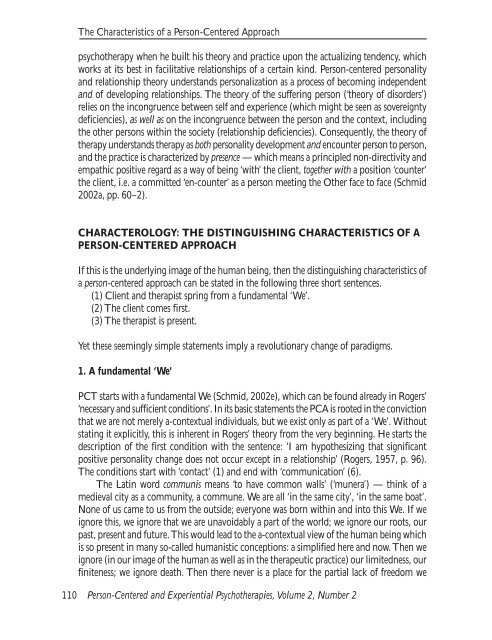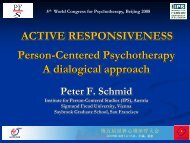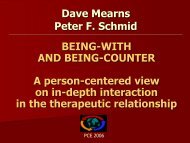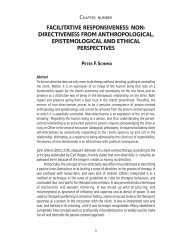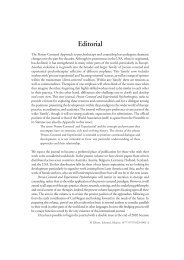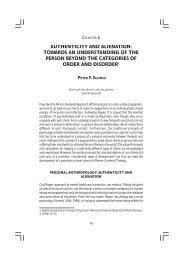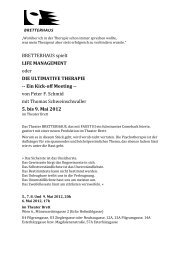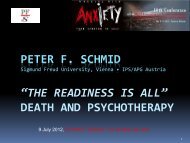The Characteristics of a Person-Centered ... - Peter F. Schmid
The Characteristics of a Person-Centered ... - Peter F. Schmid
The Characteristics of a Person-Centered ... - Peter F. Schmid
- No tags were found...
You also want an ePaper? Increase the reach of your titles
YUMPU automatically turns print PDFs into web optimized ePapers that Google loves.
<strong>The</strong> <strong>Characteristics</strong> <strong>of</strong> a <strong>Person</strong>-<strong>Centered</strong> Approachpsychotherapy when he built his theory and practice upon the actualizing tendency, whichworks at its best in facilitative relationships <strong>of</strong> a certain kind. <strong>Person</strong>-centered personalityand relationship theory understands personalization as a process <strong>of</strong> becoming independentand <strong>of</strong> developing relationships. <strong>The</strong> theory <strong>of</strong> the suffering person (‘theory <strong>of</strong> disorders’)relies on the incongruence between self and experience (which might be seen as sovereigntydeficiencies), as well as on the incongruence between the person and the context, includingthe other persons within the society (relationship deficiencies). Consequently, the theory <strong>of</strong>therapy understands therapy as both personality development and encounter person to person,and the practice is characterized by presence — which means a principled non-directivity andempathic positive regard as a way <strong>of</strong> being ‘with’ the client, together with a position ‘counter’the client, i.e. a committed ‘en-counter’ as a person meeting the Other face to face (<strong>Schmid</strong>2002a, pp. 60–2).CHARACTEROLOGY: THE DISTINGUISHING CHARACTERISTICS OF APERSON-CENTERED APPROACHIf this is the underlying image <strong>of</strong> the human being, then the distinguishing characteristics <strong>of</strong>a person-centered approach can be stated in the following three short sentences.(1) Client and therapist spring from a fundamental ‘We’.(2) <strong>The</strong> client comes first.(3) <strong>The</strong> therapist is present.Yet these seemingly simple statements imply a revolutionary change <strong>of</strong> paradigms.1. A fundamental ‘We’PCT starts with a fundamental We (<strong>Schmid</strong>, 2002e), which can be found already in Rogers’‘necessary and sufficient conditions’. In its basic statements the PCA is rooted in the convictionthat we are not merely a-contextual individuals, but we exist only as part <strong>of</strong> a ‘We’. Withoutstating it explicitly, this is inherent in Rogers’ theory from the very beginning. He starts thedescription <strong>of</strong> the first condition with the sentence: ‘I am hypothesizing that significantpositive personality change does not occur except in a relationship’ (Rogers, 1957, p. 96).<strong>The</strong> conditions start with ‘contact’ (1) and end with ‘communication’ (6).<strong>The</strong> Latin word communis means ‘to have common walls’ (‘munera’) — think <strong>of</strong> amedieval city as a community, a commune. We are all ‘in the same city’, ‘in the same boat’.None <strong>of</strong> us came to us from the outside; everyone was born within and into this We. If weignore this, we ignore that we are unavoidably a part <strong>of</strong> the world; we ignore our roots, ourpast, present and future. This would lead to the a-contextual view <strong>of</strong> the human being whichis so present in many so-called humanistic conceptions: a simplified here and now. <strong>The</strong>n weignore (in our image <strong>of</strong> the human as well as in the therapeutic practice) our limitedness, ourfiniteness; we ignore death. <strong>The</strong>n there never is a place for the partial lack <strong>of</strong> freedom we110 <strong>Person</strong>-<strong>Centered</strong> and Experiential Psychotherapies, Volume 2, Number 2


